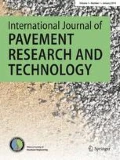Abstract
The present work evaluates the factors that affecting estimation of the Complex Shear Modulus (G*) of a binder when this estimation is done through an indirect approach: the Hirsch model. This technique consists of (i) testing specimens for dynamic modulus (E*) and (ii) back calculating the G* using the Hirsch model. To this purpose, four virgin asphalt binders were performance-graded with frequency sweeps to determine the appropriate properties. The data obtained from the laboratory tests were used in the Hirsch model for E* prediction. Subsequently, the Bulk Specific Gravity (Gsb) and G* were altered to determine the sensitivity of the Hirsch model to these estimations in terms of E*. Finally, the Gsb was altered, and the G* was estimated. The results showed that the estimation of G* presents more reproducibility for higher temperatures and lower frequencies. In conclusion, the estimation G* in hot mix asphalt designs using the Hirsch model is a promising alternative.
Similar content being viewed by others
References
A. Copeland, Reclaimed asphalt pavement in asphalt mixtures: State of the practice. FHWA-HRt-11-021. Federal Highway Administration, McLean, 2011.
K. R. Hansen, A. Copeland, Annual asphalt pavement industry survey on recycled materials and warm-mix asphalt usage: 2009–2012, National Asphalt Pavement Association, Lanham, 2013.
M. D. Nazzal, W. A. A. Mogawer, L. A. Qtaish, S. Kaya, Multi-scale evaluation of the effect of rejuvenators on the performance of high RAP content mixtures, Constr. Build. Mater. 101 (2015) 50–56.
J. Shen, S. Amirkhanian, J. Aune Miller, Effects of rejuvenating agents on superpave mixtures containing reclaimed asphalt pavement., J. Mater. Civil Eng. 19 (5) (2017) 376–384.
R. Miró, G. Valdés, A. Martínez, P. Segura, C. Rodríguez, Evaluation of high modulus mixture behaviour with high reclaimed asphalt pavement (RAP) percentages for sustainable road construction, Constr. Build. Mater. 25 (10) (2011) 3854–3862.
G. Valdés, F. Pérez-Jiménez, R. Miró, A. Martínez, R. Botella, Experimental study of recycled asphalt mixtures with high percentages of reclaimed asphalt pavement (RAP), Constr. Build. Mater. 25 (3) (2011) 1289–1297.
X. Li, M. Marasteanu, R. Williams and T. Clyne, Effect of reclaimed asphalt pavement (proportion and type) and binder grade on asphalt mixtures., J. Transp. Res. Brd. 2051 (2008) 90–97.
American Association of State and Highway Transportation Officials, Standard Method of Test for Quantitative Extraction and Recovery of Asphalt Binder from Asphalt Mixtures. AASHTO T 319. Washington, 2015.
R. West, A. Kvasnak, High-RAP-Content Mixes, Better Roads, 77 (10) (2007) 68–70.
American Association of State and Highway Transportation Officials, Standard method of test for determining dynamic modulus of hot mix asphalt (HMA). AASHTO TP 62. Washington, 2007.
D. W. Christensen Jr, T. Pellinen, R. F. Bonaquist, Hirsch model for estimating the modulus of asphalt concrete, Journal of the Association of Asphalt Paving Technologists, 72 (2003) 97–121.
M. M. Robbins, D. Timm, Evaluation of Dynamic Modulus Predictive Equations for NCAT Test Track Asphalt Mixtures, 2011.
R. S. McDaniel and R. M. Anderson, Recommended use of reclaimed asphalt pavement in the superpave mix design method: technician’s manual. NCHRP report 452. National Cooperative Highway Research Program, Washington, 2001.
A. Kvasnak, R. West, J. Michael, L. Loria, E. Hajj, N. Tran, Bulk Specific Gravity of Reclaimed Asphalt Pavement Aggregate: Evaluating the Effect on Voids in Mineral Aggregate, Transp. Res. Rec. J. Transp. Res. Brd. 2180 (2010) 30–35.
American Association of State and Highway Transportation Officials, Standard Method of Test for Bulk Specific Gravity (Gmb) of Compacted Hot Mix Asphalt (HMA) Using Saturated Surface-Dry Specimens. AASHTO T 166. Washington, 2016.
American Association of State and Highway Transportation Officials, Standard Method of Test for Determining the Rheological Properties of Asphalt Binder Using a Dynamic Shear Rheometer (DSR). AASHTO T 315. Washington, 2016.
American Society for Testing and Materials, Standard Test Method for Preparation and Determination of the Relative Density of Asphalt Mix Specimens by Means of the Superpave Gyratory Compactor. ASTM D6925. ASTM International, West Conshohocken, 2015.
A. J. Taylor, N. H. Tran, Results of Inter-Laboratory Study for AMPT Pooled Fund Study TPF-5 (178), (NCAT Report 14–01), 2014.
American Society for Testing and Materials, Standard Test Method for Determining the Rheological Properties of Asphalt Binder Using a Dynamic Shear Rheometer. ASTM D7175. ASTM International, West Conshohocken, 2015.
Author information
Authors and Affiliations
Corresponding author
Additional information
Peer review under responsibility of Chinese Society of Pavement Engineering.
Rights and permissions
About this article
Cite this article
Padula, F.R.G., Nicodemos, S., Mendes, J.C. et al. Sensitivity analysis of complex shear modulus using Hirsch model. Int. J. Pavement Res. Technol. 12, 125–130 (2019). https://doi.org/10.1007/s42947-019-0016-1
Received:
Revised:
Accepted:
Published:
Issue Date:
DOI: https://doi.org/10.1007/s42947-019-0016-1




